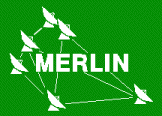
Newsletter

 |
Newsletter |  |
| Number 7: September 2002 | ||||
| MERLIN | VLBI AT JBO | PROPOSALS | ARCHIVE | CONTACT |
| Contents | |
The deadline for the receipt of proposals for Semester 03A (February 2003 - June 2003) on MERLIN is October 9th, 2002. All details are in the MERLIN web area, specifically;
Observing frequencies available:
*Only a single baseline between Cambridge and Mk2 is available in the 6GHz to 7GHz methanol band.
The availability of the various frequency bands will be determined by the user demand, and the MERLIN TAG's view of the proposed science. The Mk2 telescope will be the MERLIN homestation for L-Band observations in Semester 03A. However, the Lovell telescope will be available for MERLIN L-Band operations for a period within Semester 03A. C-Band and K-Band observations will be available in Semester 03B.
Please note that as a result of recent cuts in the MERLIN operations budget, it is no longer possible to guarantee that all requested observing bands will be available in any given Semester. Within the limits of practicality, the choice of observing band will be driven by user demand. This situation is likely to persist until full frequency flexibility is achieved around 2005 as part of the e-MERLIN upgrade.
The system parameters for observation of a continuum source in good weather conditions are;
| L-Band | Methanol & Excited OH | |
| Maximum angular resolution (mas) | ~150 | ~40 |
| R.M.S. noise level for 12 hr. on source (microJy/beam) | ~60 | ~50 |
| Maximum bandwidth per polarization (MHz) | ~15 | ~15 |
The use of the Lovell telescope at L-Band reduces the 12 hour RMS noise level to ~35 microJy/beam. The maximum rate at which the observing frequency can be switched within an observing band will be approximately once every five minutes for multi-frequency synthesis observations. For spectral line work throughout the Semester, users are referred to Section 3.4 of the MERLIN User Guide Version 1.1. The maximum number of frequency channels per baseline to be divided between the 4 polarizations for bandwidths of 16 MHz, 8 MHz and 4 MHz are 64, 128 and 256, respectively. The number of frequency channels per baseline to be divided between the 4 polarizations will be 512 for bandwidths of 2 MHz or less. The minimum total bandwidth is 250 kHz.
Proposal forms, information on MERLIN Key Programmes, and further general information can be obtained via;
The period since the last MERLIN Newsletter in March of this year has seen intense activity in several areas: observations continued until the middle of June; since then engineering staff have been involved in a major effort on several telescopes during the normal summer maintenance period. During the summer we participated in the first successful tests of the European designed disc-based VLBI system; finally, e-MERLIN developments are moving ahead.
Semester 02A was spent mainly at C/K Band. Luckily, we had an excellent spell of weather at the end of March and early April which enabled us essentially to complete the K-Band programme, a rare event in recent years. Following the summer engineering period MERLIN will return at C/K-Band for approximately two months, spending some of that time in joint observations with the European VLBI Network (EVN). We plan a change to L-Band after Christmas, at which time we expect the refurbished Lovell Telescope to be available for joint observations again.
Two major projects have occupied the engineering staff over the summer. Firstly, the new drive system was finally installed on the Pickmere telescope. As reported last year this had been impossible in the summer of 2001 because a suspected outbreak of foot-and-mouth disease at a nearby farm had resulted in no access to the telescope being possible for a good portion of the summer. However, the project has gone well this year and Pickmere is expected back in service on schedule. The second major project was the painting of the Darnhall telescope. Again, this went very well and the telescope is soon to be equipped with receivers for the upcoming observing season. In the meantime a prototype High Temperature Super-conducting filter will be tested at Darnhall in an L-Band system to quantify its ability to ameliorate the effects of nearby cellphone base-stations. Before the start of the MERLIN observing season it is also planned to use the Knockin telescope as a platform to test a new dual 30 GHz receiver system which forms the prototype of OCRA (One Centimetre Receiver Array), a proposed 100-beam receiver. Other, more routine maintenance has been performed at all other MERLIN telescopes.
It has been the dream of VLBI engineers to develop a replacement for the obsolete tape recording systems which currently power VLBI. Two developments are occurring which offer great promise in this area. A European team led by Metsahovi (Finland) and JIVE (The Netherlands) is developing a disc-based recording system called PC-EVN. In parallel, Haystack Observatory are developing the so-called MkV system. On Friday 12th July, in a special test observation, data were recorded on tape at Jodrell Bank and Westerbork. In parallel with the tape, duplicate data were recorded on the PC-EVN disc system at Westerbork. Three days later, tape-tape and tape-disc correlations on the EVN Data Processor yielded identical fringes at a data rate of 256Mb/s. This was an excellent technical achievement and bodes well for the future. JBO engineers are building a second PC-EVN system and disc-disc tests are planned for the very near future.
Last, but definitely not least, a major effort has been put into getting the e-MERLIN project off the ground. Simon Garrington, e-MERLIN Project Manager, reports on the status of the work below.
P. J. Diamond (pdiamond@jb.man.ac.uk)
Since the e-MERLIN Project was given the green light at the beginning of the year, National Facility and Observatory staff at Jodrell Bank have been defining, designing and planning the key aspects of the project. A Science Working Group was formed, with members from 11 astronomy groups around the country, which met in April to refine the overall scientific requirements and set out a series of 'Design Reference Missions' against which the project design goals could be judged. A preliminary design review was held in May, chaired by Richard Hills (Cavendish Astrophysics, Cambridge) and Arnold van Ardenne (Astron, The Netherlands), which endorsed the approach being taken in each of the key work areas. Their formal report was accepted by the first meeting, in June, of the Project Management Committee, chaired by Mr. Peter Wainwright, a Council member of The University of Manchester. The various review documents are now being drawn together as the Project Book, which will be made available on the web. The key project milestone in the next few months is the selection of design and supplier(s) for the optical fibre network, which is the backbone of e-MERLIN.
S. T. Garrington (stg@jb.man.ac.uk)
On Tuesday 27th August a significant milestone in the Lovell Telescope Upgrade was reached when the last - golden - screw was inserted to hold in place the final new galvanized surface panel making up its 76 metre diameter surface. The complete surface is made up of 340 panels each made up of seven or nine galvanized steel segments attached in place by over 100,000 screws! The surface is now being cleaned prior to painting and the return to use of the Lovell Telescope this autumn.
Early next summer the final process to complete the upgrade will take place when the panels will be individually adjusted to conform to the precise parabolic profile. When this is complete the telescope will be usable over a four times greater range of frequencies than at present - including the key MERLIN frequency of 5 GHz where it will double MERLIN's sensitivity thus giving an interim 'boost' during the years leading up to the completion of the e-MERLIN upgrade.
One consequence of the use of the telescope at shorter wavelengths is that the beamwidth becomes proportionally smaller. This requires that the telescope can track the radio source with a corresponding increase in accuracy. To this end, a completely new drive system has been installed and commissioned.
All 10 of the telescope drive motors have been replaced and will be under individual control from a sophisticated new drive system. The results of this major part of the Lovell Telescope upgrade have been excellent, with a much smoother motion and excellent tracking performance. This has also enabled the slew speed of the telescope to be increased and so reducing the time required to move from source to source thus improving the telescope's efficiency.I. Morison (im@jb.man.ac.uk)
Processing of L and C-Band continuum MERLIN data is continuing apace and maps of all sources observed in 1993, 1998 and 1999 are freely available via the web-based interface at www.merlin.ac.uk/archive. In addition, all L and C-Band data from 1994 and 1995 have been processed and will be available shortly.
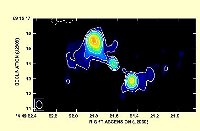 |
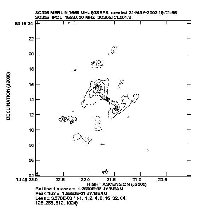 |
Soon, we will arrive at a point where we need to determine what is the next priority for addition to the MERLIN archive. For that, we would like to ask you, the MERLIN user community, for help. After the L-Band and C-Band continuum data are completed the options for what to do next are:
Your feedback on what you would like to see added to the MERLIN archive would be greatly appreciated in this matter, so please send your requests to merlin_archive@jb.man.ac.uk.
Users are reminded that MERLIN data becomes public domain one year after the end of the semester in which the observations are taken. In addition, it would be appreciated if observers of Key Programs make processed data available after publication of their results (or sooner if they wish).
We have added information to the MERLIN web pages www.merlin.ac.uk, under the (left-hand) menu topic User Information. This now contains information about the flux density of the point source calibrators used for MERLIN and flux scale determination. A new version of the MERLIN User Guide and links to data processing scripts will be available by mid-September.
The MERLIN processed data archive can now be searched via the CDS services such as Vizier. At present this provides information and links for 2 years of data similar to the MERLIN archive pages. More sources and more detailed information will soon be available. This project has been undertaken as part of the contribution of Jodrell Bank to the AstroGrid (www.astrogrid.org) and Astronomical Virtual Observatory (AVO) (www.eso.org/avo) projects, to facilitate the inclusion of radio interferometry data in multi-wavelength archives. We also have a prototype web interface to allow users to extract images from any part of the visibility data for an observation via its archive page, not requiring any knowledge of data reduction.
In January 2002, Jodrell Bank Observatory will host an AVO demonstration of virtual observing centred on analysis and extraction of scientific information from data associated with the GOODS project (www.stsci.edu/ftp/science/goods, www.eso.org/science/goods. GOODS is the Great Observatories Origins Deep Survey, looking at the two regions of sky around the HST Deep Field North and the Chandra Deep Field South at all wavelengths from radio to X-ray with unprecedented sensitivity. www.stsci.edu/ftp/science/hdf/clearinghouse/clearinghouse.html lists existing public domain observations. The huge amounts of data involved mean that not all regions of interest have been studied even in 'old' observations - including those by MERLIN. The core of the January demonstration will be ESO data, principally from the VLT (www.eso.org/science/goods/products.html) but multi-wavelength data will be used including the radio interferometry observations which are used to relate all other images to the ICRF (International Celestial Reference Frame).
A. M. McDonald (amd@jb.man.ac.uk)
Stars like the Sun become unstable at the end of their life on the main sequence. During and after they ascend the Asymptotic Giant Branch (AGB), they enter a phase of dramatic mass-loss, in which as much as half of the star is thrown off via long-period pulsations. The resulting envelopes of dust and gas, which contribute up to 80% of the dust in our Galaxy, are powerful sources of molecular maser emission. Oxygen-rich envelopes harbour hydroxyl, water and silicon monoxide masers.
MERLIN observations of water maser emission from four of these sources are the first to resolve individual water maser clouds in this class of source and so provide direct evidence for clumpy mass loss (Bains et al., MNRAS submitted). Surprisingly, most of the water maser emission comes from clouds with diameters of a few astronomical units, spanning about 1 km/s in velocity. These occupy only 1% by volume of the envelope. The clouds are distributed around the star at distances of typically 30AU, and there is a well-defined inner radius of typically 10AU, within which no water masers are seen (the maser action is quenched because of the higher density and temperature). From this we deduce that the clouds are denser than the average wind density by 1-2 orders of magnitude.
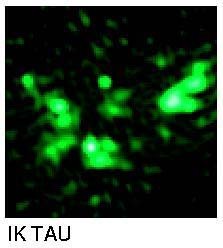 |
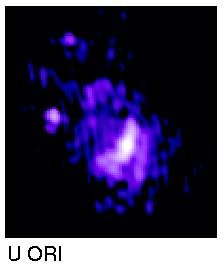 |
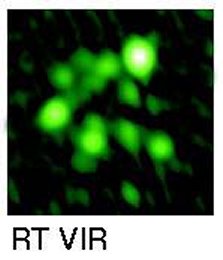 |
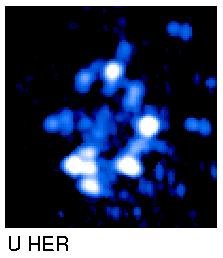 |
|
The cloud structure and the inner `hole' around the stellar position can be seen in the accompanying figure, which shows the integrated 22-GHz water maser emission from the four stars. Individual water clouds have masses of around 10-7 solar masses, with typically 50-200 clouds masing in each envelope. The clouds around these AGB stars are ten times smaller than the water vapour clouds around red supergiants previously resolved by MERLIN (Richards et al. 1999, MNRAS 306, 954, and references therein).
I. Bains (Hertfordshire)
R. J. Cohen (JBO)
A. Louridas (Kent)
A. M. S. Richards (JBO)
D. Rosa-Gonazlez (INAOE)
J. A. Yates (UCL)